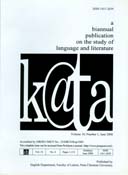Ma’i Lepera : Representation of Leprosy in selected Hawai’ian-American Literature
Abstract
This study contextualizes how disease in form of leprosy is represented in literary works by focusing of three novels written by Hawai’ian-American writers. The legacy of leprosy outbreak in Hawai’ian archipelago in the 1800’s challenges the popular imagination of Hawai’i as idealized timeless tropical paradise. This study explores how the policy of isolation exiles leprosy patients in isolated island, Moloka’i, segregated from other citizens. Hawai’ians cultural contexts concerning balance (pono), and identity based on familial ties and sense of place is employed to explore how leprosy disrupts Hawai’ian conception of identity. This study also explores the concept of ecological other as theorized by Serpil Oppermann to contextualize the stigma and harassment associated with leprosy of being unclean and contagious. The object of this study are three Hawai’ian-American novels, Hawai’i (1959), Shark Dialogues (1995) and Moloka’i (2004). This study concludes that the representation of leprosy in selected Hawai’ian-American literature contextualizes the social stigma associated toward its sufferers and disrupts the question of identity through erasure of familial history and genealogy. It further posits the possibility of reclaiming genealogy, history and ancestry lost due to leprosy and how the reclamation results in creating hybrid Hawai’ian identity.
Downloads
References
Ashcroft, B. (2001). Post-Colonial Transformation. Routledge. https://doi.org/10.4324/9781315229539-3
Carrigan, A. (2009). Tourism, culture, and reindigenization in kiana davenport’s shark dialogues and Georgia ka‘apuni mcmillen’s school for Hawaiian girls. Journal of Postcolonial Writing, 45(2), 181–190. https://doi.org/10.1080/17449850902820027
Carrigan, A. (2010). Postcolonial Disaster, Pacific Nuclearization, and Disabling Environments. Journal of Literary and Cultural Disability Studies, 4(3), 1–25.
Creswell, J. W. (2009). Research Design : Qualitative, Quantitative, and Mixed Method Approaches. SAGE Publications, Inc.
Creswell, J. W., & Poth, C. N. (1998). Qualitative Design and Research Design : Choosing Among Five Approaches. SAGE Publications, Inc.
Davenport, K. (1995). Shark Dialogues. Penguin Books.
Drager, K. (2012). Pidgin and Hawai‘i English: An overview. International Journal of Language, Translation and Intercultural Communication, 1, 61–73. https://doi.org/10.12681/ijltic.10
Firth, S. (1997). Colonial Administration and the Invention of the Native. In D. Denoon, M. Meleisea, S. Firth, J. Linnekin, K. Nero, & J. Llnnekin (Eds.), The Cambridge History of the Pacific Islanders (pp. 253–288). Cambridge University Press. https://doi.org/10.1017/chol9780521441957.009
Gussow, Z. (1989). Leprosy, Racism, and the Public Health : Social Policy in Chronic Disease Control. Westview.
Haley, J. L. (2016). Captive Paradise- A History of Hawaii. St Martin’s Press.
Hall, C. M., & Tucker, H. (2004). Tourism and postcolonialism: Contested discourses, identities and representations. In Tourism and Postcolonialism: Contested Discourses, Identities and Representations. https://doi.org/10.4324/9780203392270
Handy, E. S. C., & Pukui, M. K. (1958). the Polynesian Family System in Ka’u Hawai’i. University of Hawai’i Press.
Ho’omanawanui, K. (2000). “Hero or Outlaw? Two Views of Kaluaiko’Olau.†In Navigating Islands and Continents : Conversation and Contestation in and Around the Pacific (pp. 232–263). University of Hawai’i Press.
Indriyanto, K. (2020). Positioning the Pacific as a Disabling Environment : Reading of Kiana Davenport ’ s The House of Many Gods. Indonesian Journal of English Language Studies, 6(2), 84–92.
Inglis, K. A. (2013). Ma’i Lepera : A History of Leprosy. University of Hawai’i Press.
Inglis, K. A. (2014). Molokai Can Be Anywhere â€â€¯: Global Influence in the T Century History of Hansen ’ s Disease. Journal of World History, 25(4), 611–628.
Kay-Trask, H. (1993). From a Native Daughter : Colonialism and Sovereignty in Hawai’i. University of Hawai’i Press.
Kern, E. (2010). Sugarcane and Lepers: Health Policy and the Colonization of Hawaii (1860-1900). Penn History Review, 17(2), 5. http://repository.upenn.edu/cgi/viewcontent.cgi?article=1038&context=phr
Kong, B. (2018). Totalitarian Ordinariness: The Chinese Epidemic Novel as World Literature. Modern Chinese Literature and Culture, 30(1), 136–162. www.jstor.org/stable/26588545
Kuykendall, R. S. (1967). The Hawaiian kingdom, vol. 3, 1874-1893, the Kalakaua Dynasty. University of Hawai’i Press.
Maile, D. U. (2017). Going Native: South Park Satire, Settler Colonialism, and Hawaiian Indigeneity. Cultural Studies - Critical Methodologies, 17(1), 60–66. https://doi.org/10.1177/1532708616640562
Michener, J. A. (1959). Hawaii. Random House, Inc.
Oppermann, S. (2017). Toxic Bodies and Alien Agency : Ecocritical perspectives on ecological others. In J. G. Singh & D. D. Kim (Eds.), the Postcolonial World (pp. 412–424). Routledge.
Ralph, K. (2018). Hawaiian Authors on the Island’s Literature. Catapult.Co. https://catapult.co/stories/hawaiian-authors-on-the-islands-literature
Russell, E. (2006). Locating Cure : Leprosy and Lois-Ann Yamanaka ’ s " Blu ’ s Hanging ". MELUS, 31(1), 53–80.
Sasaki, C. T. (2016). Threads of empire: Militourism and the Aloha Wear Industry in Hawai’i. American Quarterly, 68(3), 643–667. https://doi.org/10.1353/aq.2016.0057
Stepan, N. L. (2001). Picturing Tropical Nature. Reaktion Books Ltd.
Trask, H.-K. (1991). Lovely Hula Lands: Corporate Tourism and the Prostitution of Hawaiian Culture. Borders/Lines, 23, 22–34. https://journals.lib.unb.ca/index.php/bl/article/download/24958/28913

This work is licensed under a Creative Commons Attribution 4.0 International License.
![]() This work is licensed under a Creative Commons Attribution License
This work is licensed under a Creative Commons Attribution License




.png)
.png)

.png)












